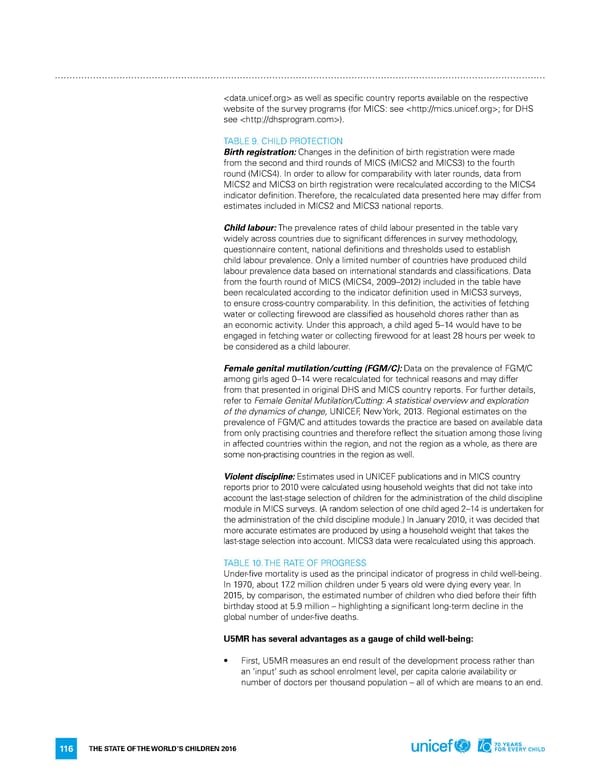as well as specific country reports available on the respective website of the survey programs (for MICS: see ; for DHS see ). TABLE 9. CHILD PROTECTION Birth registration: Changes in the definition of birth registration were made from the second and third rounds of MICS (MICS2 and MICS3) to the fourth round (MICS4). In order to allow for comparability with later rounds, data from MICS2 and MICS3 on birth registration were recalculated according to the MICS4 indicator definition. Therefore, the recalculated data presented here may differ from estimates included in MICS2 and MICS3 national reports. Child labour: The prevalence rates of child labour presented in the table vary widely across countries due to significant differences in survey methodology, questionnaire content, national definitions and thresholds used to establish child labour prevalence. Only a limited number of countries have produced child labour prevalence data based on international standards and classifications. Data from the fourth round of MICS (MICS4, 2009–2012) included in the table have been recalculated according to the indicator definition used in MICS3 surveys, to ensure cross-country comparability. In this definition, the activities of fetching water or collecting firewood are classified as household chores rather than as an economic activity. Under this approach, a child aged 5–14 would have to be engaged in fetching water or collecting firewood for at least 28 hours per week to be considered as a child labourer. Female genital mutilation/cutting (FGM/C): Data on the prevalence of FGM/C among girls aged 0–14 were recalculated for technical reasons and may differ from that presented in original DHS and MICS country reports. For further details, refer to Female Genital Mutilation/Cutting: A statistical overview and exploration of the dynamics of change, UNICEF, New York, 2013. Regional estimates on the prevalence of FGM/C and attitudes towards the practice are based on available data from only practising countries and therefore reflect the situation among those living in affected countries within the region, and not the region as a whole, as there are some non-practising countries in the region as well. Violent discipline: Estimates used in UNICEF publications and in MICS country reports prior to 2010 were calculated using household weights that did not take into account the last-stage selection of children for the administration of the child discipline module in MICS surveys. (A random selection of one child aged 2–14 is undertaken for the administration of the child discipline module.) In January 2010, it was decided that more accurate estimates are produced by using a household weight that takes the last-stage selection into account. MICS3 data were recalculated using this approach. TABLE 10. THE RATE OF PROGRESS Under-five mortality is used as the principal indicator of progress in child well-being. In 1970, about 17.2 million children under 5 years old were dying every year. In 2015, by comparison, the estimated number of children who died before their fifth birthday stood at 5.9 million – highlighting a significant long-term decline in the global number of under-five deaths. U5MR has several advantages as a gauge of child well-being: • First, U5MR measures an end result of the development process rather than an ‘input’ such as school enrolment level, per capita calorie availability or number of doctors per thousand population – all of which are means to an end. 116 THE STATE OF THE WORLD’S CHILDREN 2016
 70 Years for Every Child Page 134 Page 136
70 Years for Every Child Page 134 Page 136